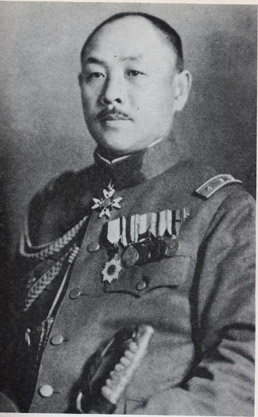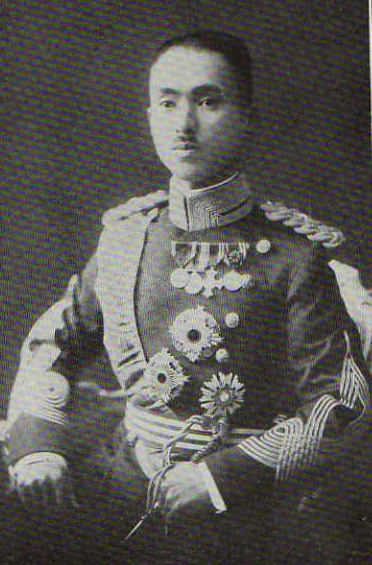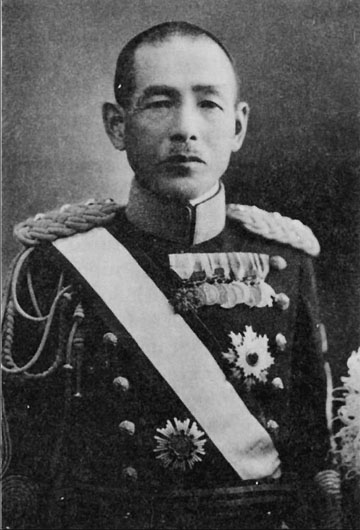<Back to Index>
- General of the Imperial Japanese Army Korechika Anami, 1887
- General of the Imperial Japanese Army Prince Yasuhiko Asaka, 1887
- Field Marshal of the Imperial Japanese Army Shunroku Hata, 1879
PAGE SPONSOR

Korechika Anami (阿南 惟幾 Anami Korechika, 21 February 1887 – 15 August 1945) was a general in the Imperial Japanese Army during World War II, and was War Minister at the surrender of Japan.
Anami was born in Taketa city in Ōita Prefecture. He attended the Imperial Japanese Army Academy, and was commissioned as a second lieutenant in the Infantry in December 1906.
In November 1918, Anami graduated from the Army War College with the rank of captain. He was assigned to the Imperial Japanese Army General Staff from April 1919 and was promoted to major in February 1922. From August 1923 to May 1925 he was assigned to the Sakhalin Expeditionary Army. Anami was promoted to lieutenant colonel in August 1925.
From August – December 1925, Anami was sent as a military attaché to France. On his return to Japan, he was assigned to the 45th Infantry Regiment, and became unit commander in August 1928.
From August 1929 - August 1930, Anami served as Aide - de - camp to Emperor Hirohito. He was then promoted to colonel.
From August 1933 - August 1934, Anami served as regimental commander of the 2nd Guard Regiment of the Imperial Guards. He was subsequently Commandant of the Tokyo Military Preparatory School, and promoted to major general in March 1935.
From August 1936, Anami served as Chief of the Military Administration Bureau of the War Ministry. He became Chief of the Personnel Bureau in March 1937 and was promoted to lieutenant general in March the following year.
With the start of the Second Sino - Japanese War, Anami was given a combat command, as Commander of the IJA 109th Division in China from November 1938. He was recalled to Japan in October 1939 to assume the role of Vice Minister of War. However, in April 1941, Anami returned to China as Commander in Chief of the IJA 11th Army, covering operations in central China. He was transferred to the Japanese Second Area Army in Manchukuo in July 1942.
In May 1943, Anami was promoted to full general. As the war conditions in the Pacific deteriorated for the Japanese, Anami was reassigned to the Southern Theater from November 1943, where he directed operations in western New Guinea and Halmahera.
Anami was recalled to Japan December 1944, becoming Inspector General of Army Aviation and Chief of the Army Aeronautical Department, while concurrently serving on the Supreme War Council (Japan). In April 1945, he was appointed War Minister.
| “ | I am convinced that the Americans had only one bomb, after all. | ” |
|
—Korechika Anami, immediately after the drop of Little Boy over Hiroshima |
||
As War Minister, an ultra - nationalistic Anami was outspoken against the idea of surrender, despite Japan's losses on the battlefield and the destruction of Japan's cities and industrial capability by American bombing. Even after the bombings of Hiroshima and Nagasaki, Anami opposed talk of surrender, and proposed instead that a large scale battle be fought on the Japanese mainland causing such massive Allied casualties that Japan would somehow be able to evade surrender and perhaps even keep some of what it had conquered.
Eventually, his arguments were overcome when Emperor Hirohito directly requested an end to the war himself; Anami's supporters suggested that he either vote against surrender or resign from the Cabinet. Instead, he ordered his officers to concede, later saying to his brother - in - law, "As a Japanese soldier, I must obey my Emperor." He informed the officers of the War Ministry of the decision, and that as it was an Imperial command, they must obey.
On 14 August 1945, Anami signed the surrender document with the rest of the cabinet, then attempted to commit suicide by seppuku early the next morning. Failing to conduct the ritual properly he had to be dispatched by his brother - in - law. His suicide note read: "I — with my death — humbly apologize to the Emperor for the great crime." This "cryptic" note is open to multiple interpretations. It is possibly a reference to his part in the aborted coup against Emperor Hirohito in the hours following Japan's decision to surrender at the end of World War II, the decision to surrender itself, or the Imperial Army's involvement with the war itself.
Anami's grave is at Tama Reien Cemetery, in Fuchū, Tokyo. His sword and blood splattered dress uniform and suicide note are on display at the Yūshūkan Museum next to Yasukuni Shrine in Tokyo.
Anami's son Anami Koreshige served as Japan's ambassador to China from 2001 – 2006.

Prince Yasuhiko Asaka (朝香宮鳩彦王 Asaka - no - miya Yasuhiko-ō, October 20, 1887 – April 12, 1981) of Japan, was the founder of a collateral branch of the Japanese imperial family and a career officer in the Imperial Japanese Army. Son - in - law of Emperor Meiji and uncle by marriage of Emperor Shōwa (Hirohito), Prince Asaka was commander of Japanese forces in the final assault on Nanking (now Nanjing), then the capital city of Nationalist China, in December 1937. He was implicated in the Nanking massacre but never charged.
Prince Yasuhiko was born in Kyoto, the eighth son of Prince Kuni Asahiko and the court lady Tsunoda Sugako. Prince Kuni Asahiko was a former Buddhist priest and minor prince descended from the Fushimi - no - miya, one the four branch houses of the imperial dynasty (shinnōke) entitled to provide a successor to the throne. In 1872, the Emperor Meiji granted him the title Kuni - no - miya and authorization to begin a new collateral branch of the imperial family. Prince Yasuhiko was a half brother of Prince Higashikuni Naruhiko, Prince Nashimoto Morimasa, Prince Kaya Kuninori and Prince Kuni Kuniyoshi, the father of the future Empress Kōjun, the consort of Emperor Shōwa.
On March 10, 1906, the Emperor Meiji granted Prince Yasuhiko the title Asaka - no - miya and authorization to begin a new branch of the imperial family. On May 6, 1909, Prince Asaka married Nobuko, Princess Fumi (August 7, 1891 – November 3, 1933), the eighth daughter of Emperor Meiji. Prince and Princess Asaka had four children
Like the other imperial princes of the Meiji period, it was expected that Prince Yasuhiko would pursue a career in the military. He received his early education at the Gakushuin Peers’ School and the Central Military Preparatory School, before graduating from the Imperial Japanese Army Academy in 1908 as a second lieutenant. Prince Asaka was promoted to captain in 1912, lieutenant colonel in 1917 and colonel in 1922.
Between 1920 and 1923, Prince Asaka studied military tactics at the École Spéciale Militaire de Saint - Cyr in France, along with his half brother Prince Higashikuni Naruhiko and his cousin Prince Kitashirakawa Naruhisa (1887 – 1923). However, on April 1, 1923, he was seriously injured in automobile accident in a Paris suburb that killed Prince Kitashirakawa and left Prince Asaka with a limp for the rest of his life.
Princess Asaka traveled to France to nurse her husband. Prince and Princess Asaka also visited the United States in 1925. During that period, Prince and Princess Asaka became enthralled with the Art Deco movement. Upon returning to Japan in 1925, Prince Asaka had a new mansion built in the Art Deco style in Tokyo's Shirokanedai neighborhood. The house was completed in May 1933, but Princess Asaka died a few months later.
Prince Asaka was promoted to the rank of Colonel in 1926. He rose to the rank of major general and was appointed an instructor at the Army Staff College in 1930. In 1933, he was promoted to lieutenant general and assumed command of the First Imperial Guards Division. In December 1935, he was appointed a member of the Supreme War Council, which gave him a very influential position with Emperor Hirohito.
However, during the abortive February 26 Incident Prince Asaka pressed the Emperor to appoint a new government that would be acceptable to the rebels, especially by replacing Prime Minister Okada Keisuke with Hirota Koki. The Prince's pro - Imperial Way Faction political sentiments, as well as his connections to other right wing army cliques, caused a rift between himself and the Emperor. It was perhaps due to this rift that Prince Asaka was transferred to the Japanese Central China Area Army (under elderly General Matsui Iwane) in China in 1937.
In November 1937, Prince Asaka became temporary commander of the Japanese forces outside Nanking (or Nanjing), then capital of China, because General Matsui was ill. As temporary commander of the final assault on Nanking between December 2 and 6, 1937, he allegedly issued the order to "kill all captives", thus providing official sanction for what became known as the "Nanking Massacre" or the "Rape of Nanking" (December 12, 1937 – February 10, 1938). However the order may have actually been issued, with the Prince's knowledge or assent, by Lieutenant Colonel Isamu Chō. He was a known radical ultra - nationalist staff member of the Central China Area Army who may have released the order under the sign manual of Asaka.
Even if Chō took the initiative on his own, Prince Asaka, who was nominally the officer in charge, gave no orders to stop the carnage. General Matsui did not arrive in the city until well after the killing had begun but similarly did not issue orders to stop the atrocities.
While Prince Asaka's responsibility for the Nanking Massacre remains a matter of debate, the sanction for the massacre and the crimes committed during the invasion of China might ultimately be found in the ratification, made on August 5, 1937 by Emperor Hirohito, of the proposition of the Japanese army to remove the constraints of international law on the treatment of Chinese prisoners.
In February 1938, with Nanking destroyed, both Prince Asaka and General Matsui were recalled to Japan. Matsui went into virtual retirement, but Prince Asaka remained on the Supreme War Council until the end of the war in August 1945. He was promoted to the rank of general in August 1939 but held no further military commands. In 1944, he colluded with Prince Higashikuni, his nephew Prince Takamatsu, and former Prime Minister Konoe Fumimaro (1895 – 1945) to oust the Hideki Tojo cabinet.
SCAP officials interrogated Prince Asaka about his involvement in the Nanking Massacre on May 1, 1946, but did not bring him before the International Military Tribunal for the Far East for prosecution. Indeed, for politico - strategic and geopolitical reasons, General Douglas MacArthur decided to support the Imperial family and to grant immunity to all its members.
On October 14, 1947, Asaka Yasuhiko and his children lost their imperial status and privileges and became ordinary citizens, as part of the American Occupation's abolition of the collateral branches of the Japanese Imperial family. He and his son were purged from holding any political or public office because they had been officers in the Imperial Japanese Army. His Art Deco mansion in Shirokanedai was seized by the government, and now houses the Tokyo Metropolitan Teien Art Museum.
The former prince, Asaka Yasuhiko, moved to Atami, on the Izu Peninsula south of Tokyo. Asaka converted to Roman Catholicism on December 18, 1951, and was the first member of the Imperial Family to do so. He spent most of his time playing golf. He also took an active interest in golf course development, and in the 1950s was the architect of the Plateau Golf Course at the Dai - Hakone Country Club. Asaka Yasuhiko died of natural causes on April 13, 1981 at his home in Atami, Shizuoka prefecture. He was 93 years old.

Field Marshal Shunroku Hata (畑 俊六 Hata Shunroku, 26 July 1879 – 10 May 1962), was a field marshal in the Imperial Japanese Army during World War II. He was the last surviving Japanese military officer with a marshal's rank.
Hata was a native of Fukushima prefecture, where his father was an ex-samurai of the Aizu domain. At the age of 12, the family relocated to Hakodate, Hokkaidō, but at the age of 14, he was accepted into the prestigious First Tokyo Middle School. However, his father died the same year, and unable to afford the tuition, he enrolled in the Army Cadet School instead, going on to graduate of the 12th class of the Imperial Japanese Army Academy, in 1901 as a second lieutenant in the artillery. Hata served in the Russo - Japanese War. He graduated from the 22nd class of the Army Staff College with top rankings in November 1910.
Sent as a military attaché to Germany in March 1912, Hata stayed in Europe throughout World War I as a military observer. He was promoted to major in September 1914 and to lieutenant colonel in July 1918, while still in Europe, and he stayed on as a member of the Japanese delegation to the Versailles Peace Treaty negotiations in February 1919.
On his return to Japan, Hata was given command of the IJA 16th Field Artillery Regiment in July 1921, and was promoted to major general and commander of the IJA 4th Heavy Field Artillery Brigade in March 1926.
Hata was subsequently assigned to the strategic planning division of the Imperial Japanese Army General Staff, serving as chief of the Fourth Bureau in July 1927 and Chief of the First Bureau in August 1928.
Hata was promoted to lieutenant general in August 1931 and became Inspector General of Artillery Training. He was then given a field command, that of the IJA 14th Division in August 1933. After serving as head of the Imperial Japanese Army Air Service from December 1935, he became commander of the Taiwan Army of Japan in 1936.
His rise after the start of the Second Sino - Japanese War was then very rapid: Military Councilor, Inspector General of Military Training and promotion rank of general all in late 1937. He was appointed as commanding general of the Central China Expeditionary Army in February 1938, to replace General Matsui Iwane, who had been recalled to Japan over the Nanjing Incident. Hata became Senior Aide - de - Camp to Emperor Shōwa in May 1939 followed by a stint as Minister of War from August 1939 to July 1940 during the terms of Prime Minister Nobuyuki Abe and Mitsumasa Yonai. In July 1940, Hata had a pivotal role in bringing down the Yonai cabinet by resigning his post as Minister of War.
Hata returned to China as commander - in - chief of the China Expeditionary Army in March 1941. He was the main Japanese commander at the time of Zhejiang - Jiangxi Campaign, during which Chinese sources claim that over 5,000,000 civilians were killed. Hata was promoted to the rank of field marshal on 2 June 1944.
Hata was requested to take command of the Second General Army, based in Hiroshima from 1944 to 1945 in preparation for the anticipated Allied invasion of the Japanese home islands. He was thus in Hiroshima at the time of the atomic bombing. Hata was one of the senior generals who agreed with the decision to surrender, but asked that he be stripped of his title of Field Marshal in atonement for the Army’s failures in the war.
Hata was arrested by the American occupation authorities after the end of the war, and charged with war crimes. In 1948, as a result of the International Military Tribunal for the Far East, he was sentenced to life imprisonment under the charges of: “Conspiracy, waging aggressive war, disregarding his duty to prevent atrocities”. Hata was paroled in 1955, and headed a charitable foundation for the welfare of former soldiers from 1958. He died in 1962, while attending a ceremony honoring the war dead.
Hata's brother, Eitaro Hata (1872 – 1930), was also a general in the Imperial Japanese Army, and commander - in - chief of the Kwangtung Army.